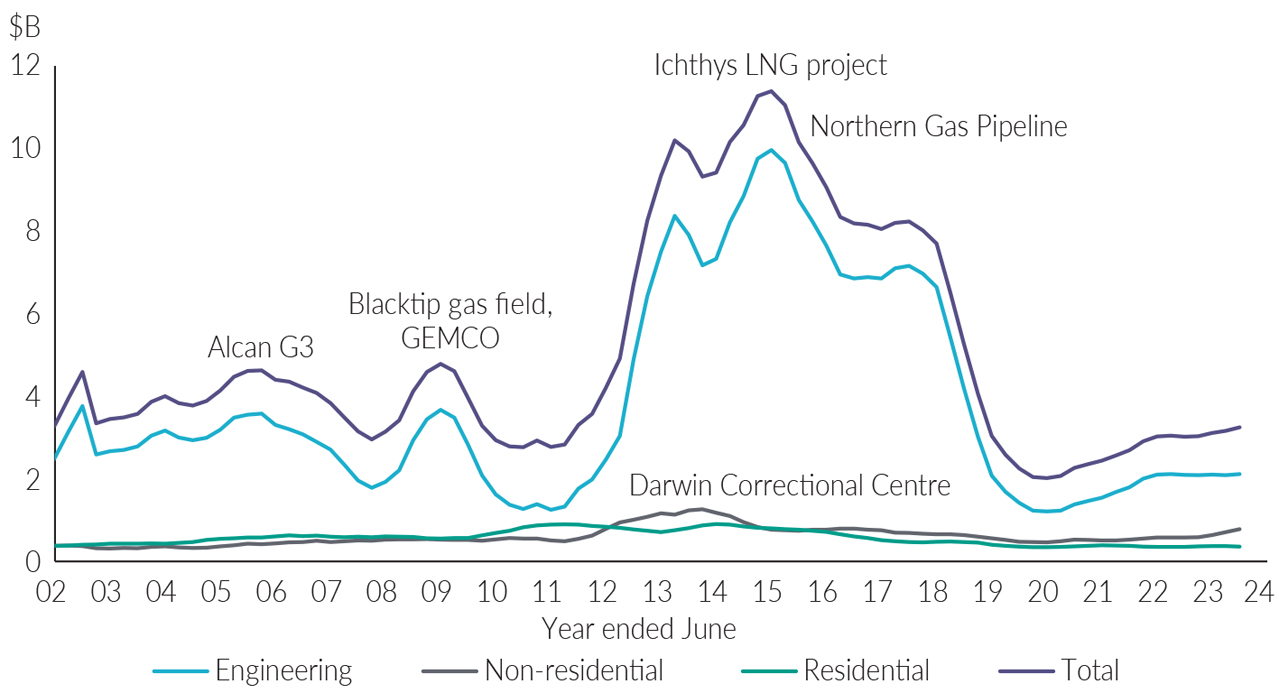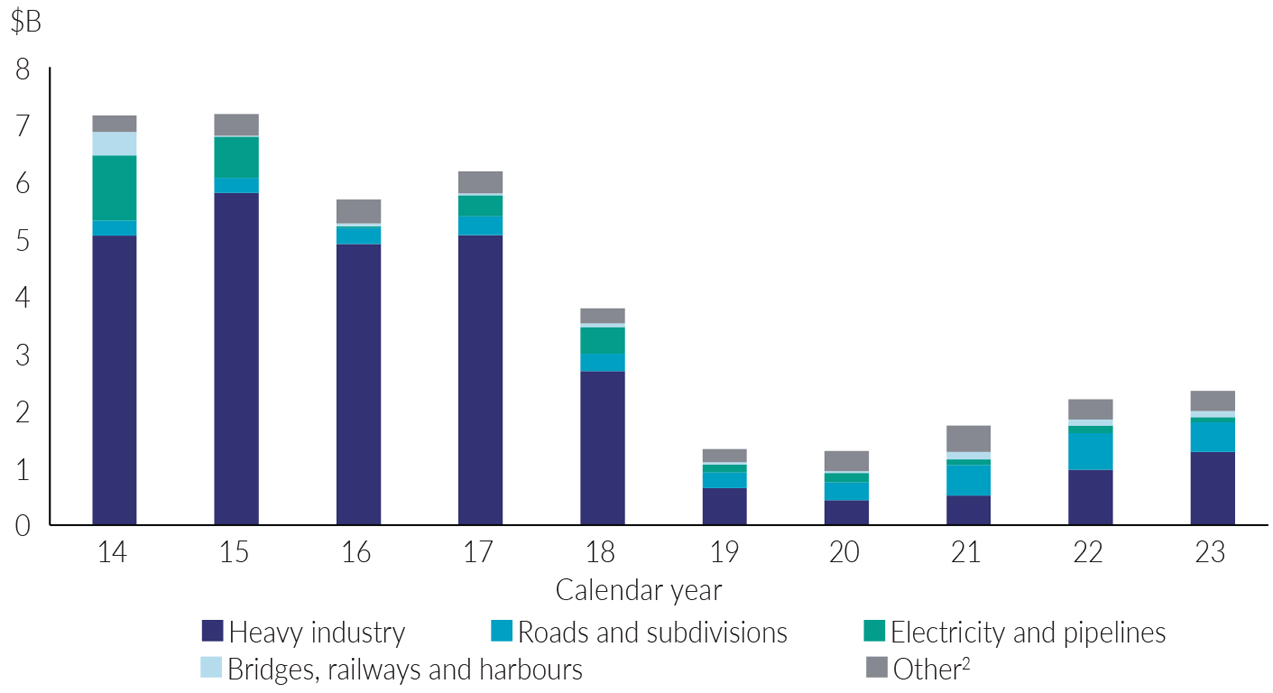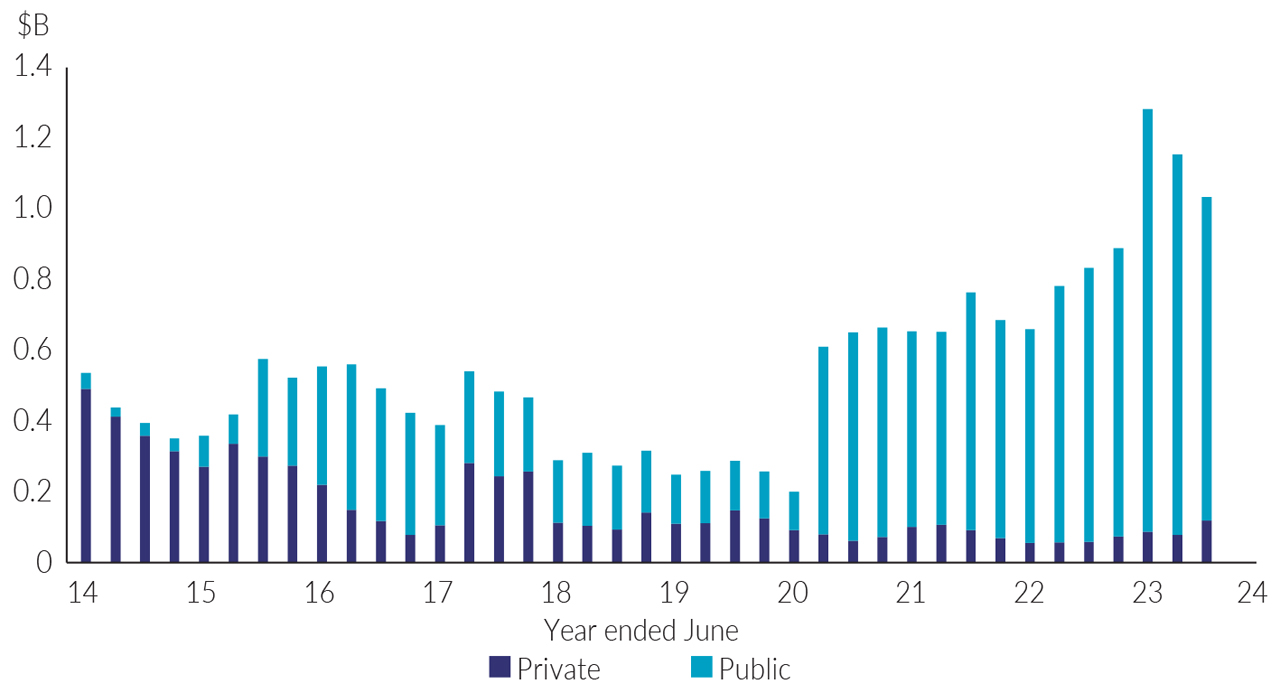Construction
Outlook
Construction activity is expected to experience moderate growth over the outlook period, supported by significant defence and natural resource-related projects.
In 2022-23, the construction sector grew by 6.6% to $1.8 billion, driven by increased non-residential construction work. The construction sector is the sixth largest industry in the Territory, accounting for 5.7% of total GSP and employing about 10,000 people.
A steady pipeline of projects is expected to support growth in construction activity over the outlook period, with the continuation of significant defence spending and ongoing works as part of the Territory’s $4.4 billion infrastructure program. There are also a number of potential private sector projects, that may reach final investment decision and increase construction activity over the outlook period. Sentiment is largely positive in the Territory construction sector due to significant investments from the Territory and Commonwealth governments, with the industry potentially constrained by a need for highly skilled workers.
Chart 6: Construction work done in the Territory1
GEMCO: Groote Eylandt Mining Company; LNG: liquefied natural gas
1 Moving annual total.
Source: ABS, Construction Work Done, Australia, Cat. No. 8755.0; Department of Treasury and Finance
The Territory Government’s commitment to deliver land to meet future growth requirements will unlock opportunities for further construction activity. Ongoing work by the Territory Government to improve the land development process through implementing recommendations of the Bringing Land to Market: An Independent Review of the Land Development Processes, Land Under Development and Titled Land report should support private sector residential dwelling construction and commercial developments. Infrastructure investment will also be supported by the Territory’s $2.3 billion transport program.
For an overview of committed and proposed major projects in the Territory, all of which will require varying degrees of construction work, see Chapter 2, Economic growth, NT Economy book PDF (2.0 MB).
Engineering
The value of engineering construction work done increased by 0.8% in 2023 to $2.1 billion (Chart 7). Private sector activity increased by 10.3% to $1.7 billion mainly due to work for heavy industry as work progressed on resource projects, and public sector activity decreased by 1% to $686 million, largely reflecting decreased work on roads, highways and subdivisions, following elevated levels in the previous year. The fall in public sector activity was partly offset by increased work on bridges, railways and harbours.
Chart 7: Value of Territory engineering construction work done by type1
1 Current prices
2 Includes water storage and supply, sewerage and drainage, telecommunications and recreation, and other.
Source: ABS, Engineering Construction Activity, Australia, Cat. No 8762.0
Defence-related projects will continue to contribute a significant amount of engineering construction work in the Territory. Construction activity at Royal Australian Air Force (RAAF) Base Tindal is expected to continue until 2027, including runway extensions and construction of new fuel storage facilities. Training area upgrades, redevelopment of Larrakeyah Barracks and HMAS Coonawarra facility upgrades will contribute over the medium term. The Territory Government’s Darwin ship lift project and associated Marine Industry Park will complement Commonwealth defence investment, and is anticipated to employ 250 workers at the peak of construction.
Significant investment into the Territory’s public infrastructure is expected over the outlook period. Investments in key water and logistic projects will support growth in the Territory economy. Construction to return Manton Dam to service, as part of the Darwin Region Water Supply Infrastructure program, has commenced. The program, which also includes the Adelaide River off-stream water storage project, will secure Greater Darwin’s water supply for the next 50 years and support the agricultural sector. Additionally, the Territory government will invest in $53.1 million into water security projects in remote and regional areas.
Rehabilitation works are anticipated to occur over the outlook period at the site of the old Rum Jungle uranium mine, with funding split between Territory and Commonwealth governments. Initial works such as preliminary roadworks and bulk earthworks are anticipated over the short to medium term. Additionally, rehabilitation works continue at the Ranger uranium mine, with works expected to continue into the outlook period.
Private sector mining and gas-related projects are expected to contribute a significant amount to engineering construction activity over the outlook period. The Tanami Expansion 2 project is expected to be completed in 2026, extending the lifetime of the Granites gold mine beyond 2040. Works at Santos’ Barossa project recommenced in early 2024, to supply a new source of gas to Darwin LNG. The life extension project at Darwin LNG is expected to be completed in the first half of 2025, with the initial gas production expected in the second half of 2025.
In March 2024, the Commonwealth announced the financing of up to $840 million for Arafura’s Nolans rare earths project in Central Australia. This funding will be used towards developing and constructing the Nolans project mine and refinery. The financing was provided through the Critical Minerals Facility, Northern Australian Infrastructure Facility and Commonwealth export financing. It should be noted, this project has not reached final investment decision and is not included in budget forecasts.
Over the long term, development of the Middle Arm Sustainable Development Precinct will aim to attract new industries including hydrogen, carbon capture, advanced manufacturing and minerals processing.
Non-residential
The value of non-residential building work done in the Territory increased by 33.8% to $770 million in 2023, with public sector activity increasing by 47.5% to $547 million and private sector activity increasing by 9.1% to $223 million. Public sector activity continues to support non-residential activity with a significant amount of work in the pipeline on the horizon (Chart 8).
Chart 8: Value of non-residential work yet to be done in the Territory, quarterly
Source: ABS, Building Activity, Australia, Cat. No 8752.0
Potential investment options for the planned construction of regional logistics hubs across the Territory are currently in development. The Commonwealth has committed $440 million towards upgrades along the Darwin-Tarcoola rail corridor to improve capacity and efficiency of rail freight and logistics infrastructure. These upgrades are aimed at improving and facilitating the development and operation of proposed mining, agriculture and energy projects.
Non-residential work in the regions will be supported through various funding agreements between the Commonwealth and Territory governments. The Barkly Regional Deal, a 10-year commitment to 2029 by all levels of government, aims to improve productivity and liveability in the region by developing social infrastructure and a mining and energy services hub to support private industry. The Jabiru Futures Package aims to redevelop Jabiru into a tourism and services centre.
Construction on the Royal Darwin hospital’s new mental health inpatient unit and upgrades to the central sterile supply department are well underway, with completion anticipated for the second half of 2025.
Construction of NextDC’s D1 $80 million data centre in Darwin commenced in late 2023, with the first stage of D1 expected to be operational in mid-2024. Planned construction of new subsea and terrestrial cables into Darwin over the outlook period will support and attract private digital investment in the Territory.
In addition, ongoing defence-related projects will contribute to non-residential construction activity over the outlook period including redevelopment of Darwin and Tindal RAAF bases, and the Robertson Barracks base improvements project.
Residential
The value of residential building work done in the Territory increased by 0.1% to $348 million in 2023, with private sector activity increasing by 4.7% to $280 million and public sector activity decreasing by 15.3% to $68 million.
Both demand and supply factors have contributed to the steady decline in residential construction activity over the past year. Increasing interest rates and input costs have dampened demand for the construction of new builds.
Chart 9: Value of residential construction work in the pipeline, quarterly
Source: ABS, Building Activity, Australia, Cat. No. 8752.0; Department of Treasury and Finance
The upcoming development of new residential land across various regions, such as Lee Point, Northcrest, Zuccoli and Kilgariff, will provide a steady supply of land for residential construction work over the coming years.
The Territory Government is also progressing its regional accelerated accommodation project, aiming to deliver 180 and 240 dwellings in Alice Springs and Katherine, respectively, with half of these dwellings to be used to accommodate key government workers. Construction of these dwellings is scheduled to start in 2024-25.
Demolition of the public housing complex on Shiers Street is nearing completion, with works to identify a community housing provider or consortium to undertake construction and management of a new public housing site in the next phase of the redevelopment.
In March 2024, the Commonwealth and Territory governments announced a joint $4 billion investment for remote housing over 10 years, with the goal of building up to 270 homes each year. Since 2016, significant progress has been made to address overcrowding in remote communities with around 3,800 homes built and upgraded.
For the latest data on the construction sector, refer to the Territory Economy website.




